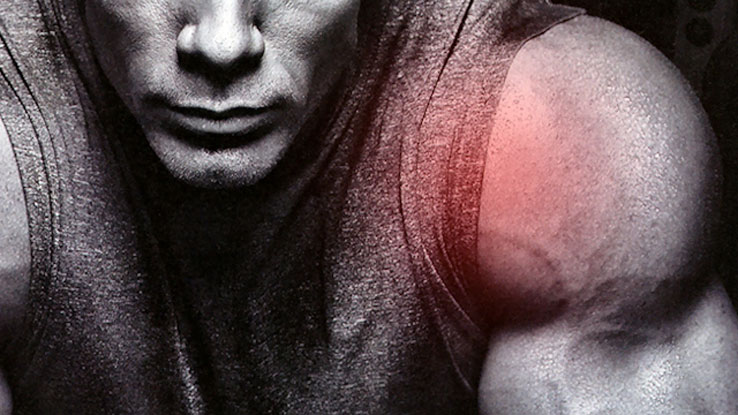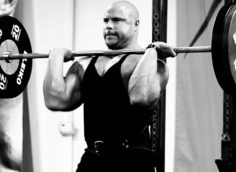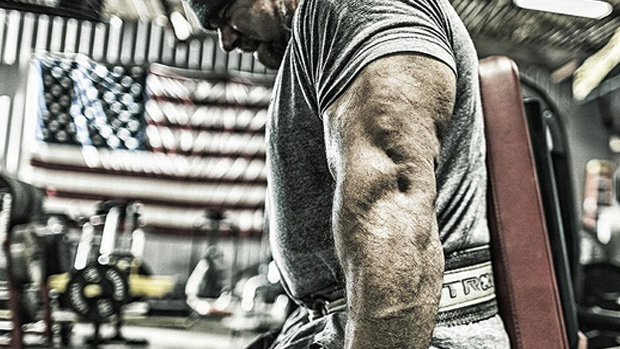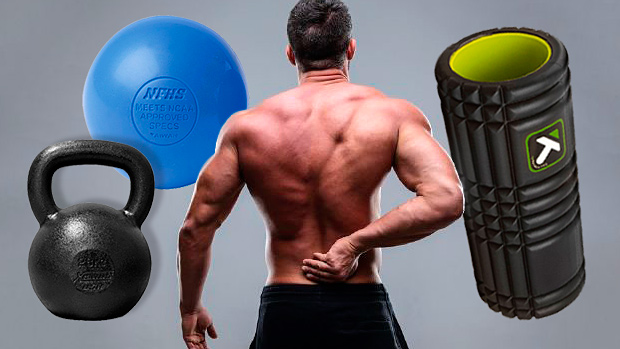T Nation readers take the iron game seriously, gladly subjecting their bodies to the relentless pursuit of getting bigger, faster, and stronger.
While every bump, bruise, and strain requires its own unique set of training modifications – or worse, time off – nothing can derail gym progress more than a nagging shoulder injury.
The shoulder – specifically, the shoulder girdle – is a complex area. It's not just one joint, which it's often mistakenly confused as, but a series of articulations consisting of the glenohumeral joint, scapulothoracic joint, acromioclavicular joint, and sternoclavicular joint.
What's more, there are 17 muscular attachments to the scapulae alone. In short, it's kind of a big deal, and where a lot of "stuff" happens.
At Cressey Performance, we deal with our fair share of injured shoulders, ranging from Major League arms to your average weekend warrior.
Of course, no two shoulders are the same, and it's important to note that there are many root causes for the source of pain. Still, for 95% of trainees, 95% of the time, we can narrow it down to one (or more) of the following:
- Overuse
- Poor programming
- Type 3 acromion
- Poor T-Spine mobility
- Scapular stability
- Rotator cuff weakness
- Opposite hip-ankle restrictions
Nothing makes me want to throw myself in front of a food truck quite like when my girlfriend watches some romantic comedy and then afterwards, wants to talk about our "feelings."
A close second would be when someone walks into our facility for the first time and mentions how much their shoulder hurts, and then ten minutes later asks when I think they'll be able to perform cleans and snatches again.
Painful lifting is rarely a good idea. In the words of Mike Boyle, "If it hurts, don't do it."
I promise you the world won't fall into an apocalyptic shit-storm if you nix cleans or benching for a few weeks. Of course, if the Mayan's had it right and 2012 is indeed the end of the world, then f-it. Bench away, tough guy. You're screwed either way.
Think of what constitutes an average guy's upper body training session. Typically it's going to include around 347 benching variations followed by, if we're lucky, some lat pulldowns.
I remember looking over a client's program who'd been working with a previous trainer and noting how one of his upper body days included a total of 16 sets that resulted in shoulder internal rotation, and zero sets which promoted more external rotation (and retraction).
What's more, while he could bench press twice his body weight for reps, he couldn't perform even one chin-up.
No wonder his shoulder was killing him.
As a rule, shoot for a 2:1 or even a 3:1 (pull:push) ratio when working with a shoulder issue. Which is to say, for every pushing exercise done (bench press, DB press, etc.), it's best to perform 2-3 pulling exercises (seated rows, DB row, chest supported row, face pull).
In a sense, we're implementing unbalanced programming structure to balance the body.
Another thing to consider is comparing one's bench press to their three-rep max chin-up.
Using myself as an example, my best bench press is 315 pounds. My best 3RM chin-up is 301 pounds (bodyweight plus external load). And it's probably no coincidence that I've had very little incidence of shoulder issues in my training career.
While my N=1 correlation by itself doesn't mean much, I've seen similar results with all my athletes and clients who maintain a close proximity between their bench press and chin-up numbers.
Want healthy shoulders? Up your game on those chins! And include more horizontal rowing movements into your repertoire.
This one is undoubtedly the one you have the least control over. You were born with one of three possible acromion variations – Type I, Type II, and Type III.
Acromion type is evenly distributed throughout the population – about 33% each – and it dictates how much space there is for the rotator cuff to "breathe" during exercises like overhead pressing and other movements.
Those with a type I acromion – congratulations! You picked the right parents and can pretty much get away with as much overhead pressing, bench pressing, upright rows, dips, dwarf tossing, etc. as your passionate heart desires.
P.S. I hate you.

Those with a Type II, and especially Type III acromion, aren't so lucky. Do too many sets of the wrong exercises and acromion space can diminish, thereby compromising the rotator cuff.
Since your only option is surgically shaving off the bone (usually a last resort), your best bet would be to nix those exercises that shorten the acromion space.
Start by dumping the barbell pressing. Straight-bar bench pressing "locks" you into a pronated grip, which promotes more internal rotation, resulting in a shortened acromion gap. So switching to all dumbbell pressing variations is step one.
We can also use a neutral grip with dumbbells, which allows for more external rotation and opens up the gap a bit so that the rotator cuff can slide through more freely.
Moreover, loaded push-ups are another excellent option in this scenario. While they often get the short end, push-ups offer a lot of bang for your training buck and are infinitely more shoulder friendly compared to barbell bench pressing.
Similarly, most overhead pressing variations are out of the question, although using a neutral grip may be an option for some.
Finally, I'd be leery of any straight bar back squats. Much like the bench press, back squatting promotes an "at risk" position of the glenohumeral joint (in this case maximal abduction and external rotation). The easy substitute here would be front squats or safety bar squats if you have access to a safety squat bar.
For many, this section will serve as a nice starting point, as lack of t-spine mobility is going to play into most (if not all) shoulder dysfunctions.
To prove a point, let's start with a little game. Stand up and round your upper back and then try to elevate your arms – palms facing one another – up above your head by bringing them out in front of you and reaching towards the ceiling.
Chances are, you didn't get too far. And even if you did, you compensated in one way or another, most likely by substituting shoulder flexion with excessive lumbar extension.
Now, "un-round" your back and try to assume a more optimal spinal position and repeat the same sequence, reaching your arms up towards the ceiling.
A lot easier, right?
In the former scenario, with the spine in a kyphotic position, shoulder kinematics are way out of whack, resulting in increased incidence of impingement, not to mention a more anteriorly tilted (winged out) scapulae, which can have ramifications down the road.
In the latter, with the spine in a more "natural" position, the scapulae are now more posteriorly tilted (and depressed), and as such, are able to function optimally with little interference, and consequently, less incidence of injury.
When someone lacks t-spine mobility, as is the case with an overly kyphotic posture, things like overhead pressing are going to be problematic.
I don't have anything against overhead pressing, but given the unfortunate fact that many of us have the movement quality of a ham sandwich, it's just not worth the risk.
Fortunately there are some simple drills that can help address the issue:
Optimal scapular stability is imperative for overall shoulder health. If one lacks stability in their shoulder, force can't be as easily transferred, and things like performance in the bench press won't be up to par.
In the past when addressing this, I've always placed a premium on including more direct work for the lower traps as they, along with the serratus anterior, tend to be woefully weak.
I'd also avoid any direct upper trap work, considering the research at the time showing that upper trapezius dominance plays a significant role in sub-acromial impingement.
The last thing you want to do with a muscle that's already jacked up or overactive is to target it even more. This is often the case when you're dealing with someone who sits in front of a computer all day and then heads to the gym, grabs a barbell, and performs shrug variations to make his traps swole.
In this instance, they'll undoubtedly play into the dysfunction (upper cross syndrome, among others) and probably have a pissed off shoulder to boot.
Still, there are instances where some upper trap work is warranted.
The upper traps play a role in scapular upward rotation, and as such, optimizing their function is worth some of our time.
Think of it this way. We're constantly telling athletes and clients to retract and depress their scapulae. Normally this isn't a bad thing, as it targets the lower traps more and will help offset upper trap dominance. But sometimes, it can be to the detriment of the shoulder.
Take the following exercises and how we typically prefer to cue them:
- Seated Rows: Pull the shoulder blades together and down.
- Chin-Ups: Keep the shoulder blades in your back pocket (depressed).
- Deadlifts: Shoulder blades "locked" and set (and subsequently the upper traps are on stretch).
- Farmer Carries: Don't shrug, set the shoulders (again, upper traps are on stretch).
Soon you may notice a downwardly rotated scapula due to a lengthened upper trapezius. In this scenario, the excessive length makes the upper trap weak and a less than effective upward rotator of the scapula.
I don't need to reiterate that less than optimal upward rotation is going to be a massive monkey wrench when it comes to shoulder health and performance, especially concerning overhead athletes.

But even for the non-overhead athlete, it's something to consider. Take me for example. Other than that being the coolest t-shirt ever, what else do you notice about this picture?
See the sloped angle of the shoulders? Definitely not ideal, and sets the shoulder girdle a little too low for optimal function. Now thankfully, my baseball career is long over and I don't suffer from any long-term shoulder issues. Nevertheless, some dedicated upper trap work would be in high order for someone like me.
The key, though, is to step away from the stupid and not hightail it for the barbell shrugs. Instead, perform a movement where the scapulae are already in an upwardly rotated position, which places a larger activation on the upper traps, which will help offset the pull of the downward rotators (rhomboids and levator).
Here's an excellent exercise I "stole" from Boston based physical therapist Eric Shoenberg called the "Half Kneeling 1-Arm Band Overhead Shrug" that fits the bill nicely:
Some other exercises to consider would be DB (or kettlebell) overhead shrugs or even face pulls with the elbows more abducted.
Don't be too concerned with using a lot of load with any of these variations. Focus on quality of movement and allowing the upper trap to do the work.
Many trainees will at one point or another enter what's known as "shoulder prehab mode." Others may call it shoulder rehab, preventative maintenance, or "the stuff you always say you're going to do but tend to skip at the end of your workout anyways." Yeah, I do it too.
Contrary to popular belief, there's no need to get fancy with rotator cuff work. I don't know where the notion came from, but there are a lot of coaches and personal trainers who feel that unless there's a smoke machine, pyrotechnics, or worse, a BOSU ball involved, the exercise is useless.
Surprisingly, the side lying external rotation – arguably the simplest rotator cuff exercise in existence – is one of the most effective.
EMG tests have repeatedly shown that this exercise induces greater activity in the infraspinatus and teres minor. Furthermore, with the arm abducted (slightly), either with a towel or half foam roller, more emphasis is placed on the rotator cuff and less on the deltoids.
The key, despite the simplicity of the exercise, is performing it correctly.
The two main things to consider are:
- Not using too much weight.
- Not training the rotator cuff to fatigue.
With regards to the first point, you don't need to use a lot of weight in order to effectively stimulate the rotator cuff. So despite thinking how badass it is that you're performing max effort rotator cuff work, it's dumb, ineffective, and you should stop doing it.
Instead, use lighter weight (5-15 lbs) and place a premium on doing the exercise correctly, with no compensation patterns (specifically with the lower back). See the video below.
With regards to the second point, acclaimed physical therapist Mike Reinold has noted that training the rotator cuff to fatigue increases superior humeral head migration.
Put another way, when the rotator cuff is fatigued, the humeral head will shift superiorly towards the acromion process, effectively increasing the likelihood of shoulder impingement.
So all of those 20-50 rep sets of band or side lying dumbbell external rotations you're doing to keep your shoulder "healthy" isn't doing your shoulder any favors.
While I can appreciate people wanting to work hard and push their body to the limits, direct rotator cuff training requires more tact than brawn. Drop the weight, do it correctly, and focus on quality of reps rather than quantity.
As an aside, it's important to consider the actual role of the rotator cuff. Many are quick to say that the rotator cuff's main job is to externally/internally rotate and abduct the shoulder. While any Jeopardy! geek would agree that that's the case, unfortunately, it's a bit more complicated than that.
The rotator cuff's main function is simply to center the humeral head within the glenoid fossa. To that end, rhythmic stabilizations are a superb rotator cuff exercise as it forces the muscles of the rotator cuff to fire in a more "functional" manner. See the video below.
We like to use these as a "filler" exercise during rest intervals. After performing your main movement (i.e. deadlifts), kneel down on the floor and have your partner gently tap each arm for 10-15 seconds/per side.
You could do these on your own, but the unpredictable pattern is the key to the exercise.
Other variations include (see videos below):
A lot of fitness professionals jump to the conclusion that shoulder problems stem from opposite hip/ankle restrictions in an attempt to make themselves sound smarter than they really are.
While a case could be made for it, I could also make a case that lack of big toe dorsiflexion is the culprit, too.
Here's a thought: keep the magic tricks to a minimum and let more qualified physical therapists and practitioners handle this one. If the shoulder hurts, it more than likely has to do with something closer to the joint itself.
In the end, I really only hit the tip of the iceberg. I didn't even mention other important factors like poor exercise technique, poor glenohumeral ROM, poor cervical spine function, or even faulty breathing patterns.
Collectively, though, these points should be a fantastic starting point for anyone suffering from shoulder pain.
You can't avoid every injury, but you can minimize the risk – be mindful of your shoulders, practice intelligent programming, and listen to your body. You have a lifetime of training in front of you.





